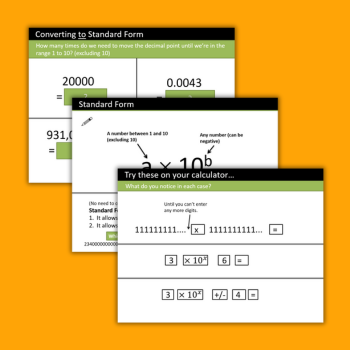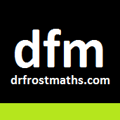Standard form question sheet (Word doc) and PowerPoint presentation
KS3
Years 7-9
This download includes a PowerPoint presentation explaining standard form, and a worksheet with questions for students to complete. The worksheet also includes an answer key for teachers.
Learning objectives:
- appreciate the need to put big and small numbers in a more readable form
- how to write numbers in standard form
- calculations involving numbers in standard form.
These activities will support students to be able to:
- understand why putting numbers in standard form is useful (particularly in science)
- be able to use the x10^ button on their calculator
- convert numbers to and from standard form
- multiply and divide numbers in standard form.
Dr Frost is a maths teacher working at Tiffin School in London. You can find all of his resources at his website drfrostmaths.com, including a huge bank of PowerPoints, worksheets and activities spanning Year 7 to Further Maths.
Adding and subtracting numbers in standard form
Numbers written in standard form can be confusing for students to add or subtract. Colin Foster explains how to teach this tricky topic…
The difficulty
Which of these numbers is in standard form and which isn’t? How can you tell?
2.1×104 and 37×104
The first number is in standard form, because it’s of the form a×10n, where 1≤a<10 and n is an integer.
The second number isn’t in standard form, because 37>10.
How would you write 37×104 in standard form?
In standard form, this number would be 3.7×105. The 37 has been divided by 10 and the 104 has been multiplied by 10, making 105, so the product is unchanged. We can imagine a factor of 10 leaving the 37 to join the 104.
How would you add up these two numbers?
Students may be unsure, or they may suggest wrong answers, such as 5.8×105 or 5.8×1010.
The solution
It’s easier to see the answer to this question if we go back to the way the original two numbers were presented:
2.1×104 and 37×104
Both numbers are written as multiples of 104: we have 2.1 lots of 104 plus 37 lots of 104. So, we can add 2.1 and 37, because the ‘units’ are the same: 2.1×104+37×104=39.1×104.
We can think of this as ‘counting in ten thousands’. Giving the answer in standard form, it would be 3.91×105.
How could you do this by ‘counting in hundred thousands’ instead of by ‘counting in ten thousands’?
We could write both numbers as multiples of 105: 2.1×104+3.7×105=0.21×105+3.7×105=3.91×105. Get students to explain what’s happened here.
Which way do you think is easier? Why?
Make up five examples of additions like this. Solve them in both ways (i.e. by making the powers of 10 match in two different ways, like this).
Students may see an analogy with finding common denominators when adding fractions. In both cases, we need to find a ‘common unit’ before we can add.
How would you work out the difference between the two numbers that we started with?
The process is almost identical. To find the difference, we first need to decide which number is larger, and then subtract the smaller number from this:
37×104 is greater than 2.1×104, so we calculate 37×104−2.1×104=34.9×104=3.49×105. Alternatively, in 105s, we have 3.7×105−0.21×105=3.49×105.
Checking for understanding
How would you find the sum and the difference of these two numbers?
2.1×103 and 37×105
What is different this time?
The method is the same here, but the numbers happen to be further apart in size. This time, we can choose to work in units of 103, units of 105 or units of 106. However we do it, the sum comes to 3.7021×106 and the difference comes to 3.6979×106.
Students should sense-check their answers by noting in advance that both answers must be ‘around 4 million’.
Colin Foster is a Reader in Mathematics Education in the Department of Mathematics Education at Loughborough University. He has written many books and articles for mathematics teachers. Visit his website at foster77.co.uk
More maths resources
- Browse more KS3 maths games and lesson ideas
- Download maths question worksheets for Year 7, Year 8, Year 9 and GCSE maths
- Browse GCSE maths games
- Download more Key Stage 3 maths worksheets













